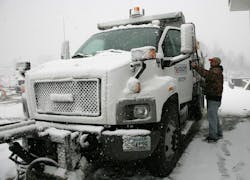As Winter Storm Dion finishes whipping its way across the U.S. this week and a second storm prepares to slam into the Mid-Atlantic region tonight and tomorrow, attention is once again being focused on state transportation agencies that by and large bear the brunt of snow removal duties when such weather strikes.
Yet one of the more interesting stories about such activity – stories that are often well below the radar of the new business – is how state DOT groups are deploying a variety of technologies, including more “earth-friendly” chemistry, to improve their winter-weather response capabilities.“Keeping highways open and safe during major winter weather events can present some serious challenges for state transportation departments,” Tony Dorsey (seen at right), spokesman for the American Association of State Highway and Transportation Officials (AASHTO) told me by email this morning. “But over the years, a growing number of states have turned to new technology and environmentally sensitive solutions to cut costs and improve efficiency.”
For example, he noted that the Utah Department of Transportation (UDOT) is using solar-powered HomeView Technologies road condition monitoring cameras at remote locations throughout the state so supervisors can eyeball locations first before dispatching their snow plows.
The low-cost web cameras use high speed wireless communication and infrared sensors to broadcast video from distant mountains passes or other problem areas and getting that “first look” helped UDOT save some $200,000 back in 2010 when they first deployed the system just from improving how and when snow plows get dispatched.
Dorsey also pointed to the Maintenance Decision Support System (MDSS) deployed by the Colorado Department of Transportation (CDOT) three years ago which combines advanced weather and road condition prediction with rules of practice to help operators determine the proper application of anti-icing and de-icing chemicals on a route-by-route basis. CDOT is also now using automatic de-icing systems to spray liquid de-icers once on-site sensors detect a decrease in surface temperatures and an increase in moisture, Dorsey said.
Virginia’s Department of Transportation (VDOT) is also using something similar, relying in part on a network of 77 weather sensors in roadways and bridges, plus 16 mobile video data platforms, to allow snow removal crews to quickly identify when and where road surfaces might be freezing.Then there’s the California Department of Transportation (Caltrans) that, along with other Golden State agencies, is tapping into WeatherShare, a new web-based tool that sends alerts, warnings and advisories (depending on the level of danger of course) for fog, ice, winds, fire and more.
That system sends weather data to Caltrans’ transportation management center operators, maintenance staff and other agencies, such as Emergency Medical Services and the California Department of Forestry and Fire Protection, Dorsey noted, helping provide for a better coordinated response to weather emergencies.
Then there’s the use of new chemistry, illustrated by the use of a substance called “Magic Salt” by the Tennessee Department of Transportation (TDOT). Made from potato juice, “Magic Salt” is a biodegradable, non-corrosive and environmentally friendly concoction; indeed, Maryland’s State Highway Administration (SHA) is using something similar only made from beet juice.
Yet advances good old-fashion hardware is not being overlooked, either. Take for example the 26-foot-wide “tow plow” designed to be pulled behind a conventional plow truck, allowing two interstate travel lanes to be cleared and treated in a single pass.
Believe it or not, the “tow plow” is the brainchild of a Missouri Department of Transportation (MoDOT) employee who applied his knowledge of farm equipment to snowplows, with the agency eventually working with a snowplow contractor to design and build the version in use today by multiple state DOT agencies.Indeed, back in Tennessee, another new snow plow configuration, this one a 14-footer, is being used in greater numbers by TDOT to keep the roads clear. Those 14-foot plows are more than four feet wider than traditional plows and have the ability to clear an entire travel lane in one pass. Some TDOT trucks are also now fitted with new “underbody” plows to help remove hard-packed ice from the roadway.
And the innovation isn’t slowing down, either, as VDOT is in the midst of testing six all-weather truck-mounted cameras, located on the rear of the cab, to snap photos every few seconds en route to snow plow dispatch locations to help provide real-time information on road conditions as well as whether and when a road is plowed or not.
“Each technology and piece of equipment we pursue aims to help crews clear roads faster and more efficiently, and enables us to provide more real-time information to the public on our operations and progress during storms,” noted Branco Vlacich, VDOT northern Virginia maintenance engineer, at the agency’s annual snow briefing back in November.
And with the winter blast that’s struck a goodly part of the U.S. this week, all of those snow-fighting innovations will no doubt be seeing a lot of action.



